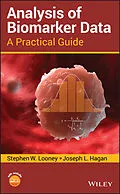A "how to" guide for applying statistical methods to biomarker data analysis
Presenting a solid foundation for the statistical methods that are used to analyze biomarker data, Analysis of Biomarker Data: A Practical Guide features preferred techniques for biomarker validation. The authors provide descriptions of select elementary statistical methods that are traditionally used to analyze biomarker data with a focus on the proper application of each method, including necessary assumptions, software recommendations, and proper interpretation of computer output. In addition, the book discusses frequently encountered challenges in analyzing biomarker data and how to deal with them, methods for the quality assessment of biomarkers, and biomarker study designs.
Covering a broad range of statistical methods that have been used to analyze biomarker data in published research studies, Analysis of Biomarker Data: A Practical Guide also features:
- A greater emphasis on the application of methods as opposed to the underlying statistical and mathematical theory
- The use of SAS®, R, and other software throughout to illustrate the presented calculations for each example
- Numerous exercises based on real-world data as well as solutions to the problems to aid in reader comprehension
- The principles of good research study design and the methods for assessing the quality of a newly proposed biomarker
- A companion website that includes a software appendix with multiple types of software and complete data sets from the book's examples
Autorentext
STEPHEN W. LOONEY, PHD, is Professor in the Department of Biostatistics and Epidemiology at Georgia Regents University, USA. He is a Fellow of the American Statistical Association and the Royal Statistical Society, an elected member of the International Statistical Institute, and a member of the International Biometric Society.
JOSEPH L. HAGAN, SCD, is Research Statistician at Texas Children's Hospital and Assistant Professor at the Baylor College of Medicine, USA. He is a member of the American Statistical Association.
Inhalt
Preface xiii
Acknowledgements xvii
1 Introduction 1
1.1 What is a Biomarker? 1
1.2 Biomarkers Versus Surrogate Endpoints 2
1.3 Organization of This Book 3
2 Designing Biomarker Studies 5
2.1 Introduction 5
2.2 Designing the Study 6
2.2.1 The Exposure-Disease Association 6
2.2.2 Cross-sectional Studies 7
2.2.3 Case-Control Studies 7
2.2.4 Retrospective Cohort Studies 9
2.2.5 Prospective Cohort Studies 9
2.2.6 Observational Studies 10
2.2.7 Randomized Controlled Trials 11
2.3 Designing the Analysis 13
2.3.1 Choosing the Appropriate Measure of Association 15
2.3.1.1 Odds Ratio versus Risk Ratio 15
2.3.1.2 Consequences of Not Choosing the Appropriate Measure of Association 16
2.3.2 Choosing the Appropriate Statistical Analysis 16
2.3.3 Choosing the Appropriate Sample Size 17
2.4 Presenting Statistical Results 18
Problems 20
3 Elementary Statistical Methods for Analyzing Biomarker Data 21
3.1 Introduction 21
3.2 Graphical and Tabular Summaries 21
3.3 Descriptive Statistics 26
3.4 Describing the Shape of Distributions 31
3.5 Sampling Distributions 33
3.6 Introduction to Statistical Inference 34
3.6.1 Point Estimation and Confidence Interval Estimation 34
3.6.2 Hypothesis Testing 38
3.7 Comparing Means Across Groups 43
3.7.1 Two Group Comparisons 44
3.7.2 Multiple-Group Comparisons 45
3.8 Correlation Analysis 50
3.9 Regression Analysis 52
3.9.1 Simple Linear Regression 52
3.9.2 Multiple Regression 55
3.9.3 Analysis of Covariance 58
3.10 Analyzing Cross-Classified Data 61
3.10.1 Testing for Independence 61
3.10.2 Comparison of Proportions 65
Problems 69
4 Frequently Encountered Challenges in Analyzing Biomarker Data and How to Deal with Them 72
4.1 Introduction 72
4.2 Non-Normally Distributed Data 73
4.2.1 The Effects of Non-Normality 73
4.2.2 Testing Distributional Assumptions 74
4.2.2.1 Graphical Methods for Assessing Normality 74
4.2.2.2 Measures of Skewness and Kurtosis 81
4.2.2.3 Formal Hypothesis Tests of the Normality Assumption 83
4.2.3 Remedial Measures for Violation of a Distributional Assumption 86
4.2.3.1 Choosing a Transformation 86
4.2.3.2 Using a Robust Statistical Procedure 92
4.2.3.3 Distribution-Free Alternatives 93
4.3 Heterogeneity of Variance 113
4.3.1 The Effects of Heterogeneity 113
4.3.2 The Importance of Heterogeneity in the Comparison of Means 113
4.3.2.1 Comparisons of Two Groups 113
4.3.2.2 Comparisons of More Than Two Groups 116
4.3.2.3 Multiple Comparisons 118
4.4 Dependent Groups 122
4.4.1 The Consequences of Ignoring Dependence Among Groups 122
4.4.2 Comparing Two Dependent Means 124
4.4.2.1 Paired t-test 124
4.4.2.2 Wilcoxon Signed Ranks Test 127
4.4.2.3 Sign Test 128
4.4.3 Tests of Dependent Proportions 134
4.4.3.1 McNemar's Test 134
4.4.3.2 Cochran's Q test 138
4.4.3.3 Sample Size and Power Considerations 142
4.5 Correlated Outcomes 144
4.5.1 Choosing the Appropriate Measure of Association 144
4.5.1.1 Spearman's rho 144
4.5.1.2 Kendall's tau-b 146
4.5.2 Recommended Methods of Statistical Analysis for Correlation Coefficients 148
4.5.3 Recommended Methods for Interpreting Correlation Coefficient Results 156
4.5.4 Sample Size Issues in Correlation Analysis 157
4.5.5 Comparison of Correlation Coefficients 171
4.5.5.1 Comparison of Independent Correlation Coefficients 172
4.5.5.2 Comparison of Dependent Correlation Coefficients 174
4.5.6 Sample Size Issues When Comparing Two Correlation Coefficients 181
4.5.6.1 Sample Size Issues When Comparing Independent Correlation Coefficients 181
4.5.6.2 Sample Size Issues When Comparing Dependent Correlation Coefficients 183
4.6 Clustered Data 184
4.7 Outliers 199
4.7.1 The Effects of Outliers 199
4.7.2 Detection of Outliers 199
4.7.3 Methods for Accommodating Outliers 207
4.8 Limits of Detection and Non-Detected Observations 208
4.8.1 Statistical Inference When NDs Are Present 210
4.8.2 Maximum Likelihood Estimation of a Correlation Coefficient When Both X and Y Are Subject to Non-Detects 210
4.8.3 Comparison of Confidence Interval Methods for Correlation Coefficients When Both Variables Are Subject to Limits of Detection 212
4.9 The Analysis of Cross-Classified Categorical Data 221
4.9.1 Choosing the Appropriate Measure of Association 221
4.9.1.1 The Odds Ratio 221
4.9.1.2 Risk Ratio 223
4.9.1.3 Risk Difference 224
4.9.1.4 Odds Ratio for Paired Data 225
4.9.2 Choosing the Appropriate Statistical Analysis 225
4.9.3 Choosing the Appropriate Sample Size 226
4.9.4 Choosing a Statistical Method When Both t…
